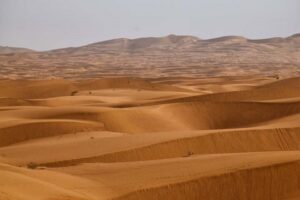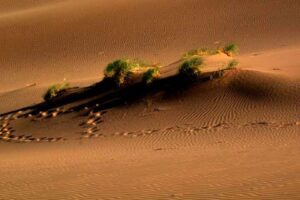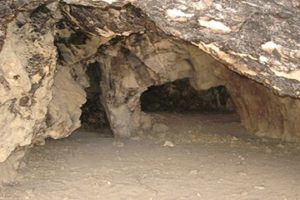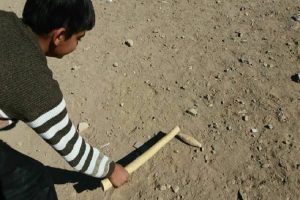In order to see Maranjab desert and go into the sandy expanse, it is necessary to first go to Kashan and then to Aran and Bidgol district. It is a close neighbor of a salty lake called Mesila, and the road leads to the desert national park. In every corner of Maranjab, we will face a stretch of sand and sand hills. Only those who can find the beauty of the desert behind its rolling soil will realize the beauty hidden in the Maranjab desert. To see all the wonders of this land, one should go 40 km away from the city of Aran and Bidgol and stay on the road that leadss to Maranjab and its beautiful desert.

Maranjab is derived from the name of a historical caravanserai that was built during the Safavid era by order of Shah Abbas I to be a resting place for the Silk Road caravans that brought their goods from the farthest lands to Iran and travels to near and far lands, from different parts of Iran. In this carvansaria, from where the desert starts, there were also many Safavid soldiers stationed to guard the lives and the goods on the caravans. So Maranjab Caravanserai was not only a resting place but also a military barracks. Protecting the Silk Road was very important and valuable for the Safavid government and linked to the country’s economy.
About etymology of Maranjab desert and its name, it is said that since digging wells to build aqueducts in the desert was very difficult and the sand did not allow digging into the ground, the name of this area became “man, water, hardships (mard-ranj-aab). Gradually this name turned into Maranjab. Such an etymology is most probably legendary and fictious, and the mean of this name should be found elsewhere.

A variety of vegetation can be seen in the Maranjab desert; especially, the Nettle plant is abundant in that area. Similarly, there is a shrub called Tag in Maranjab, which has long and hanging stems and is green, scattered throughout the desert. The height of this shrub reaches four meters. Ghich tree is also abundant in Maranjab. This tree grows in salty soil, and its flowers are yellow.
Maranjab desert wildlife is also abundant. Wolves, jackals and foxes live in this desert, and hyenas and boars also roam in it. Recently, a cougar was identified in this desert. The natives consider the number of these cougars to be much more.
There is also a place for historical structures and natural attractions around Maranjab. One of the old structures of Maranjab is a square-shaped caravanserai with six towers. This is the same caravanserai we mentioned earlier and said it was built for commercial caravans.
Wandering (sargardoun) island is also one of the tourist attractions of the Maranjab desert. Unlike other islands, this island is covered with salt instead of water. During the rainy season, the vision of the passers-by of the Maranjab desert makes the wandering island look like a mirage, and this point may be the reason for deceiving them to take the wrong path and wander in the desert. It should also be said that the wandering island is not visible all year round and disappears in certain months of the year.
Dastkan (hand-sug) well is another attraction of Aran and Bidgol desert. It is near the carvansarai. This well has fresh water. The Kanjeh well salt marsh is also nearby. There are raised lands around this well, and the salt marsh can be seen on all sides. That is why it is spectacular.

Sonbak: a place in the heart of Maranjab with amazing sinkholes (pits) where watermelons are planted.
Another spectacular place in the Maranjab desert is Chaleh Sonbak or watermelon pits). This area is located in the middle of the smooth sands of the desert. Farmers plant watermelons in these pits, and so they are called watermelon pits. Despite the high amount of water, the evaporation point is zero, and water is not wasted. Maranjab desert is a favorite place for desert lovers. Walking on the soil and sand of Maranjab creates a pleasant and lasting memory in my mind, and passing by the salt fields is not without spectacle!










